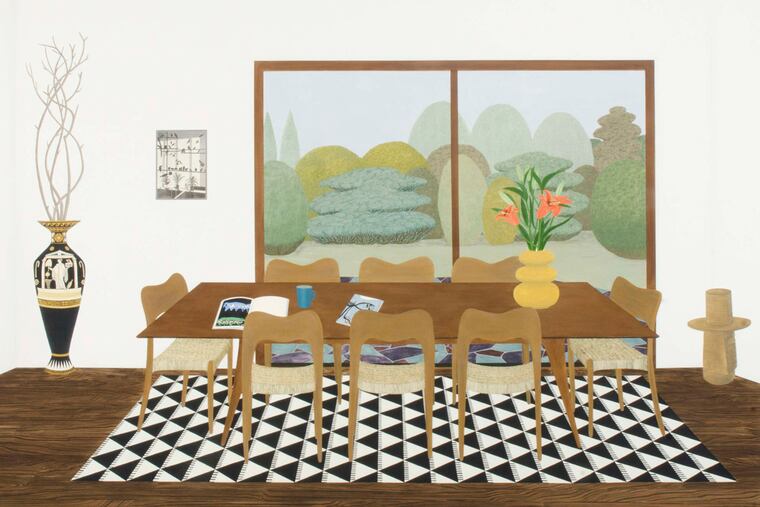Galleries: Becky Suss' art dreams mid-century dreams
At a time when exhibition titles tend to stretch into lines of prose, the decision to call Becky Suss' first solo museum show simply "Becky Suss" seems not only a good omen, but a perfect introduction to paintings that make just as strong an imp

At a time when exhibition titles tend to stretch into lines of prose, the decision to call Becky Suss' first solo museum show simply "Becky Suss" seems not only a good omen, but a perfect introduction to paintings that make just as strong an impression on their own - I had previously seen them in group shows in and around Philadelphia in recent years - as they now do together on the walls of the Institute of Contemporary Art. As organized by associate curator Kate Kraczon, Suss' crisp paintings also echo the architecture of the Eleanor Biddle Lloyd Gallery on the ICA's second floor. It's an enclosed, meditative space that complements the orderly calm of Suss' images.
Though small, the earliest paintings in the exhibition, both from 2010, portray the same view of a rectangular backyard in Kensington, one lushly green in summer and the other brittle and snow-covered in winter. They hint at the large, spartan paintings to come three years later, a body of work inspired by Suss' recollections of her grandparents' mid-century house on Long Island, but filled with liberal spoonfuls of poetic license.
In one such painting, Living Room (Yogi 2), Suss offers an ostensibly straight-on view of her grandparents' living room, with its minimalist fireplace of white bricklike tiles alongside which collected objects have been artfully positioned - the head from a Mexican sculpture, a fragment of white coral, a Native American vase incorporating white patterns. The room's whiteness is further emphasized by a West Highland White terrier stretched out on the white carpet, with a sliver of a window in the background revealing a white birch tree on an emerald lawn.
Interestingly, though the rooms Suss paints are spacious, she typically makes much of one large element in a scene, and that element is often composed of a pattern, such as the aforementioned brick pattern of the fireplace. She likes to bring the outdoors indoors through the use of windows and mirrors.
Those two tendencies come together particularly dramatically in her 2015 painting Bedroom (Rubáiyát of Omar Khayyám). The banana-palm-leaf-patterned wallpaper on a back wall, which Suss based on the Beverly Hills Hotel's iconic decoration, dwarfs the room's other, more modest appurtenances, among them a twin bed and a bedside table with a lamp and books. A full-length mirror offers a reflection of an interior entranceway framed by an outdoor railing.
One senses this room is the artist's inventory of her past, and curator Kraczon more or less confirms this in her essay for the exhibition, revealing that the lamp was Suss' mother's girlhood lamp and that one of the books is a volume of poetry the artist admired as a child.
Suss brushed up her skills as a ceramicist in preparation for her show, and her glazed low-fire ceramic vases and stacks of lifesize ceramic "books" and glazed stoneware iterations of pre-Columbian Mexican and Maori heads, all placed on the floor at strategic intervals, have the clever effect of making Suss' paintings look like windows into other rooms.
Which, come to think of it, they are.
Institute of Contemporary Art, 118 S. 36th St., 11 a.m. to 8 p.m. Wednesdays; 11 a.m. to 6 p.m. Thursdays and Fridays; 11 a.m. to 5 p.m. Saturdays and Sundays. 215-898-7108 or www.icaphila.org. Free. Through Dec. 27.
Arboreal musings
If you have yet to familiarize yourself with the work of Ellen Harvey, a British-born Brooklyn artist, there's no time like the present.
Harvey is perhaps best known for her haunting monochromatic installations in which architecture and landscapes, especially ruins, are reimagined through the use of hand-engraved mirrors and lighting (and that is the half of it - she also counts painting among her many media).
Besides her installation "Metal Painting," at the Barnes Foundation, which runs through Jan. 4, Harvey is having her fourth solo show at the Locks Gallery.
"The Museum of Ornamental Leaves" comprises new works such as The Forest of Obsolete Ornaments, pairing sculptural casts of the leaf molds used for ornamental architecture detailing with her own two-dimensional images of trees, as well as earlier works that are featured in her recently published, 302-page monograph, The Museum of Failure.
One of those works is a life-size version of a souvenir stand, Alien Souvenir Stand (2013), which was part of her exhibition "The Alien's Guide to the Ruins of Washington, D.C.," at that city's now-closed Corcoran Gallery of Art. Her interpretation of what an entrepreneurial alien would sell to tourists visiting the ruins of contemporary Washington seems corny and obvious when separated from its original context. On the other hand, her painting New Forest/The Internal Revenue Service Reforested, in which she imagines the abandonment of the Andover, Mass., IRS complex, and its subsequent swallowing by nature, is an eerie, unforgettable image.
Locks Gallery, 600 Washington Square, 10 a.m. to 6 p.m. Tuesdays through Saturdays. 215-629-1000 or www.locksgallery.org. Through Saturday.